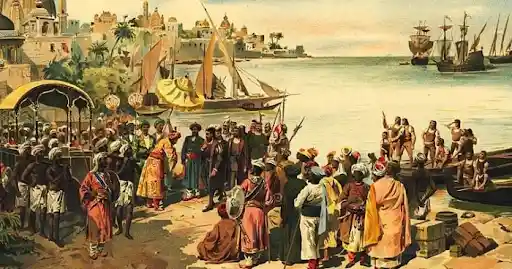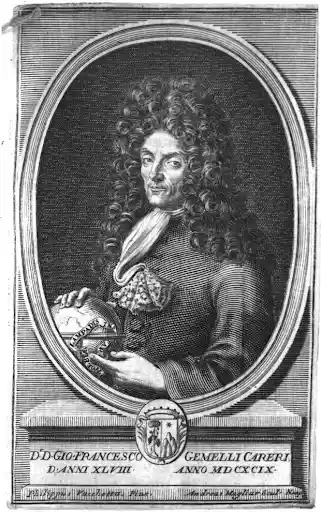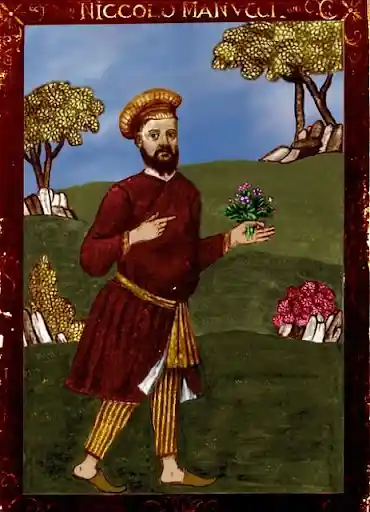Bringing the World Closer: Tales of Travels
Beyond shoe-box skyscrapers and stifling urban cityscapes lay a limitless world of the unknown. Into the dense woods and above the gigantic waves; across seven oceans and a hundred rivers, some hearts seek refuge in the enigmatic travels. Our diverse world has witnessed travellers with inquisitive natures who truly set the stepping stones for what is today called the ‘global village’. An east-west synthesis, coupled with mutual curiosity for each other’s cultures, has been made possible by these envoys who lived to venture into uncharted waters.

(Travellers arriving on the banks of Indian ports; Source: Google images)
Stacks of history books on our dusty bookshelves narrate a similar tale - India’s past exists in stories. The land of the golden eagle that tempted hundreds of invasions also created well-documented history in the process. The influx of foreigners began as early as the Delhi Sultanate and it heightened during the Mughal Emperor Jahangir’s rule. Through their eyes, we procure a glimpse of the forgotten past. Apart from acting as a memoir, it also provided a third-person view of the traditions that make up our multicultural ethos. The grand exploits of some travellers have stood the test of time, while some remain widely overlooked. Today, as you sit, leisurely, with your phone in hand, imagine yourself delving deeper into their adventures all around the world, especially India, whose golden wings and vibrant cultural ethos attracted travellers from all around the world.
Pietro Della Valle, an Italian composer, was one such traveller who sought adventures across Asia. Interestingly, his travels were meant to soothe his soul after suffering heartbreak in love. Born during the Renaissance, Della Valle’s spirit had embarked to achieve new heights. It was the time when ambition reigned supreme and his life was a glowing example of the same. After sojourning across the Middle East and meticulously observing local festivities, habits, and traditions as honest accounts of his ‘pilgrimage’, he finally set out for Surat, a port city in India, in around 1623-24. He painted vibrant, insightful, and unbiased portraitures of all places he resided in, including some Mughal provinces, Southern kingdoms, and especially Goa.
He also witnessed the marriages of the two eldest sons of Shah Jahan, one of the greatest Mughal emperors who commissioned and supervised the building of famous monuments like the Taj Mahal and Lal Qila or Red Fort, among many others. “Extremely curious and a sharp observer, he is estimated to have travelled more than 162 thousand kilometres, surviving close to “2000 perils”. Itinerarium Mundii is an impressive and epic travel journal he wrote on his voyages between 1608 and 1667", as mentioned by an author on Medium.
Your thoughts now start to shift as you gaze at an unfinished encounter with Around The World In Eighty Days, the book left in half abandoned. Your imagination runs wild as you wish to visit every corner of the world as well. But did you know whose voyages might have inspired the book itself?
It was Giovanni Francesco Gemelli Careri, an Italian adventurer and traveller of the seventeenth century whose unquenchable wanderlust made him one of the most prominent European travellers.
Known to have spent a great amount of time in the Mughal Court, Manucci's observations about Indian society during the Mughal Era are extraordinary. According to him, Indian courts had a "richness and magnificence" that European courts could not compete with. Meanwhile, the wide variety of food habits and how inexorably interconnected they were with the caste hierarchy in Hinduism was noted with interest by the Venetian adventurer.
Abstaining from meat and fish, the Brahmins and sages, especially worshipping cows as a sacred figure of Hindu mythology feature in his writings. Even the custom of dressing in white by Hindu widows piqued his interest in this multi-lingual and vibrant amalgamation of communities. As a matter of fact, his accounts provide an interesting detail of Shah Jahan's preference for Dara Shikoh over Aurangzeb as the next monarch in line. He notes that Dara's seat beside the King's throne was just a little lower and only he had permission to remain seated in the Emperor's presence.
These four travellers belonged to times and backgrounds so utterly different, but a common thread of curiosity and thirst for adventure strings them together. All our modern civilizations are indeed built upon the daring desire to push their limits of the known and it is people like them who have made it possible. Their contributions have enriched our own history and moulded our relations with other nations at the same time.
He was also introduced to King Venkatappa Nayaka of Keladi, in present-day Karnataka. He recorded that the king was an “able soldier and administrator”. "Several of his experiences included animated conversations with Hindoo Brahmins about whether the Egyptians or Indians first came up with the concept of reincarnation, a dialogue with a woman who invited him to her upcoming sati, and a description of the barefoot 'Queen of Olaza', who was out on the embankments giving directions to her engineers", as popular records about the wandering traveller go.
Imagine a lazy wintry morning wrapped in a blanket, as you sit by the window. The birds squeal in delight to herald a new day as you still try to get accustomed to your unwilling wakefulness. A book you'd abandoned halfway last night lay on the bedside table along with a cup of lukewarm tea. Its aroma rejuvenates the morose air around you as you sit to wonder, who was the first Briton to record his tasting of chaa or tea?
It was Peter Mundy, a British trader, traveller and writer, who landed on Indian soil in 1628 at Surat. Being a merchant had its own share of financial risks and extensive journeying across the subcontinent, from Agra in present-day Uttar Pradesh to Patna in Bihar. Encompassing losses and gains, Mundy’s experiences as an accomplished and acute observer of his surroundings have sustained his travelogues, reliable even today. Another man of the Renaissance, it was rare to find someone so representative of his period. Curiosity was the ruling passion of his life, along with his insatiable appetite for information, his eye for detail, and his desire for accuracy.
Unlike Mundy and Della Valle, Careri alighted on Indian soil in Daman, in the year 1695. His inland journey from Goa to Galgalia, a city in present-day Bihar, led him to encounter the Mughal emperor Aurangzeb's army. His narratives have proved to be a significant source of reference for the last great and most controversial Mughal emperor's reign. Topics as various as "the climate, fruit, flowers, minerals, beasts, and coins of Indostan, Hindu theology, anecdotes of the camp, convent and harem, accidents by water and land" paint an ethnic and natural landscape of the Indian subcontinent.
Literature and History are intricately co-dependent and influence each other constantly. Niccolao Manucci, a Venetian writer, physician and traveller, authored the book Storia Do Mogor; or, Mogul India, chronicling the Mughal era from 1653, during Shah Jahan's rule.

(A portrait of Pietro Della Valle, source: Wikipedia)

(Sir Gemelli Careri's Portrait, Source: Wikipedia)

(Portrait of Niccolao Manucci, Source: Alchteron - The Free Social Encyclopaedia)

(Portrait of Niccolao Manucci, Source: Alchteron - The Free Social Encyclopaedia)


